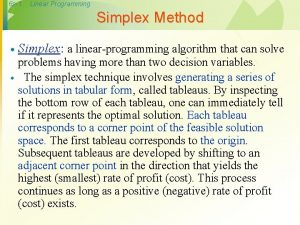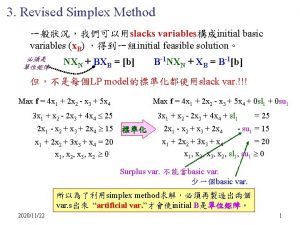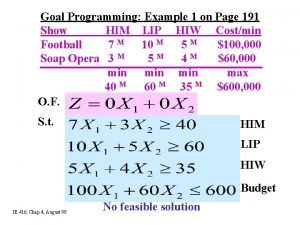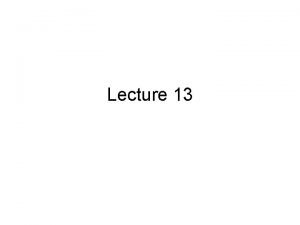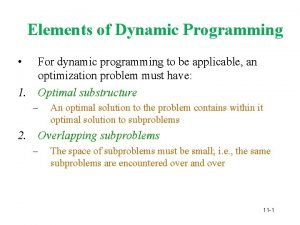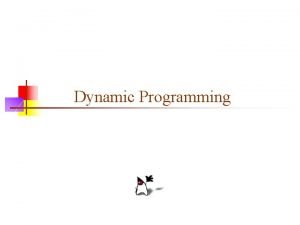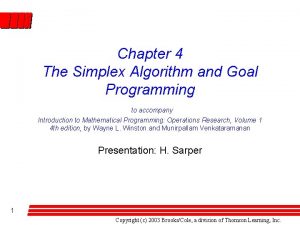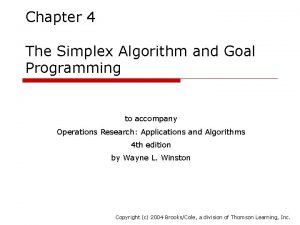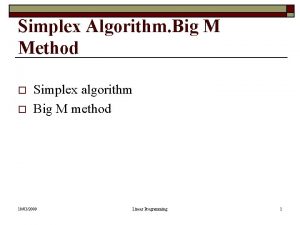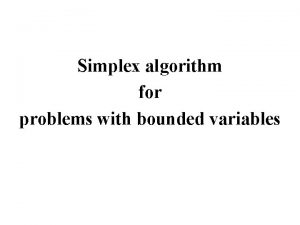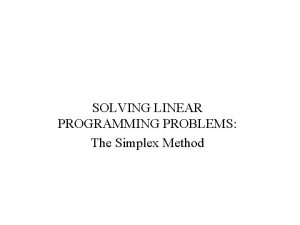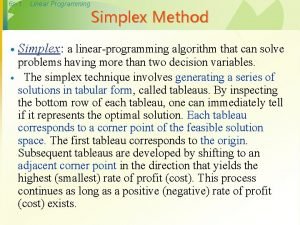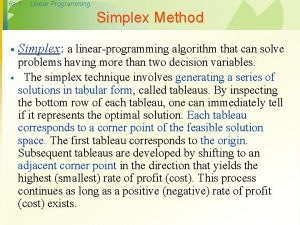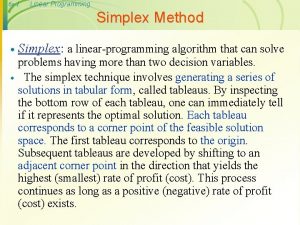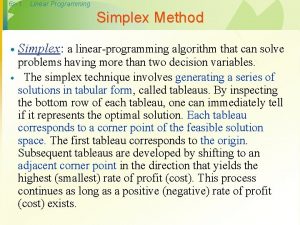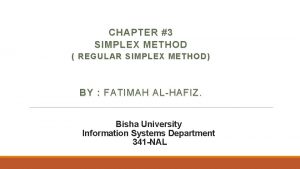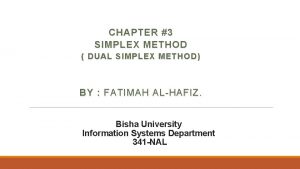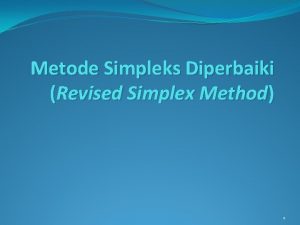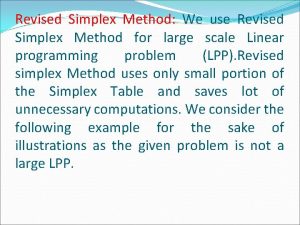Chapter 4 The Simplex Algorithm and Goal Programming






























- Slides: 30

Chapter 4 The Simplex Algorithm and Goal Programming to accompany Operations Research: Applications and Algorithms 4 th edition by Wayne L. Winston Copyright (c) 2004 Brooks/Cole, a division of Thomson Learning, Inc.

4. 1 How to Convert an LP to Standard Form n Before the simplex algorithm can be used to solve an LP, the LP must be converted into a problem where all the constraints are equations and all variables are nonnegative. n An LP in this form is said to be in standard form. 2

Example 1: Leather Limited n Leather Limited manufactures two types of leather belts: the deluxe model and the regular model. o Each type requires 1 square yard of leather. o A regular belt requires 1 hour of skilled labor and a deluxe belt requires 2 hours of skilled labor. o Each week, 40 square yards of leather and 60 hours of skilled labor are available. o Each regular belt contributes $3 profit and each deluxe belt $4. n Write an LP to maximize profit. 3

Example 1: Solution n The decision variables are: o x 1 = number of deluxe belts produced weekly o x 2 = number of regular belts produced weekly n The appropriate LP is: max z = 4 x 1 + 3 x 2 s. t. x 1 + x 2 ≤ 40 (leather constraint) 2 x 1 +x 2 ≤ 60 (labor constraint) x 1, x 2 ≥ 0 4

n To convert a ≤ constraint to an equality, define for each constraint a slack variable si (si = slack variable for the ith constraint). A slack variable is the amount of the resource unused in the ith constraint. n If a constraint i of an LP is a ≤ constraint, convert it to an equality constraint by adding a slack variable si to the ith constraint and adding the sign restriction si ≥ 0. 5

n To convert the ith ≥ constraint to an equality constraint, define an excess variable (sometimes called a surplus variable) ei (ei will always be the excess variable for the ith ≥ constraint. o We define ei to be the amount by which ith constraint is over satisfied. n Subtracting the excess variable ei from the ith constraint and adding the sign restriction ei ≥ 0 will convert the constraint. n If an LP has both ≤ and ≥ constraints, apply the previous procedures to the individual constraints. 6

4. 2 Preview of the Simplex Algorithm n Consider a system Ax = b of m linear equations in n variables (where n ≥ m). n A basic solution to Ax = b is obtained by setting n – m variables equal to 0 and solving for the remaining m variables. o This assumes that setting the n – m variables equal to 0 yields a unique value for the remaining m variables, or equivalently, the columns for the remaining m variables are linearly independent. n Any basic solution in which all variables are nonnegative is called a basic feasible solution (or bfs). 7

4. 5 The Simplex Algorithm n The simplex algorithm can be used to solve LPs in which the goal is to maximize the objective function. Step 1 Convert the LP to standard form Step 2 Obtain a bfs (if possible) from the standard form Step 3 Determine whether the current bfs is optimal Step 4 If the current bfs is not optimal, determine which nonbasic variable should become a basic variable and which basic variable should become a nonbasic variable to find a bfs with a better objective function value. Step 5 Use EROs to find a new bfs with a better objective function value. Go back to Step 3. 12

Example 2: Dakota Furniture Company n The Dakota Furniture company manufactures desk, tables, and chairs. o The manufacture of each type of furniture requires lumber and two types of skilled labor: finishing and carpentry. o The amount of each resource needed to make each type of furniture is given in the table below. Resource Desk Table Chair Lumber 8 board ft 6 board ft 1 board ft Finishing hours 4 hours 2 hours 1. 5 hours Carpentry hours 2 hours 1. 5 hours 0. 5 hours 13

Ex. 2 - continued n At present, 48 board feet of lumber, 20 finishing hours, 8 carpentry hours are available. A desk sells for $60, a table for $30, and a chair for $ 20. n Dakota believes that demand for desks and chairs is unlimited, but at most 5 tables can be sold. n Since the available resources have already been purchased, Dakota wants to maximize total revenue. 14

Example 2: Solution n Define: o x 1 = number of desks produced o x 2 = number of tables produced o x 3 = number of chairs produced n The LP is: max z = 60 x 1 + 30 x 2 + 20 x 3 s. t. 8 x 1 + 6 x 2 + x 3 ≤ 48 4 x 1 + 2 x 2 + 1. 5 x 3 ≤ 20 2 x 1 + 1. 5 x 2 + 0. 5 x 3 ≤ 8 x 2 ≤ 5 (lumber constraint) (finishing constraint) (carpentry constraint) (table demand constraint) x 1, x 2, x 3 ≥ 0 15

Ex. 2: Solution continued n Begin the simplex algorithm by converting the constraints of the LP to the standard form. n Then convert the LP’s objective function to the row 0 format. n To put the constraints in standard form, simply add slack variables s 1, s 2, s 3, s 4, respectively to the four constraints. n Label the constraints row 1, row 2, row 3, row 4, and add the sign restrictions si ≥ 0. 16

Ex. 2: Solution continued n Putting rows 1 -4 together in row 0 and the sign restrictions yields these equations and basic variables. Basic Variable Canonical Form 0 Row 0 z – 60 x 1 – 30 x 2 – 20 x 3 Row 1 8 x 1 + 6 x 2 + x 3 + s 1 Row 2 4 x 1 + 2 x 2 + 1. 5 x 3 Row 3 2 x 1 + 1. 5 x 2 + 0. 5 x 3 Row 4 x 2 + s 3 + s 4 =0 z=0 = 48 s 1 = 48 = 20 s 2 = 20 =8 s 3 = 8 =5 s 4 = 5 17

Ex. 2: Solution continued n To perform the simplex algorithm, we need a basic (although not necessarily nonnegative) variable for row 0. o Since z appears in row 0 with a coefficient of 1, and z does not appear in any other row, we use z as the basic variable. o With this convention, the basic feasible solution for our initial canonical form has n BV = {z, s 1, s 2, s 3, s 4} n NBV = {x 1, x 2, x 3}. o For this initial bfs, z=0, s 1=48, s 2= 20, s 3=8, s 4=5, x 1=x 2=x 3=0. n A slack variable can be used as a basic variable if the rhs of the constraint is nonnegative. 18

Ex. 2: Solution continued n Once we have obtained a bfs, we need to determine whether it is optimal. n To do this, we try to determine if there is any way z can be increased by increasing some nonbasic variable from its current value of zero while holding all other nonbasic variables at their current values of zero. o Solving for z in row 0 yields: Z = 60 x 1 + 30 x 2 + 20 x 3 19

Ex. 2: Solution continued n For each nonbasic variable, we can use this equation to determine if increasing a nonbasic variable will increase z. o Increasing any of the nonbasic variables will cause an increase in z. o However increasing x 1 causes the greatest rate of increase in z. If x 1 increases from its current value of zero, it will have to become a basic variable. o For this reason, x 1 is called the entering variable. Observe x 1 has the most negative coefficient in row 0. 20

Ex. 2: Solution continued n Next choose the entering variable to be the nonbasic variable with the most negative coefficient in row 0. n Goal is to make x 1 as large as possible but as it increases, the current basic variables will change value. Thus, increasing x 1 may cause a basic variable to become negative. n This means to keep all the basic variables nonnegative, the largest we can make x 1 is min {6, 5, 4} = 4. 21

Ex. 2: Solution continued n Rule for determining how large an entering variable can be. o When entering a variable into the basis, compute the ratio for every constraint in which the entering variable has a positive coefficient. n The constraint with the smallest ratio is called the winner of the ratio test. n The smallest ratio is the largest value of the entering variable that will keep all the current basic variables nonnegative. 22

Ex. 2: Solution continued n Always make the entering variable a basic variable in a row that wins the ratio test. n To make x 1 a basic variable in row 3, we use elementary row operations (EROs) to make x 1 have a coefficient of 1 in row 3 and a coefficient of 0 in all other rows. o This procedure is called pivoting on row 3; and row 3 is called the pivot row. o The final result is that x 1 replaces s 3 as the basic variable for row 3. The term in the pivot row that involves the entering basic variable is called the pivot term. 23

Ex. 2: Solution continued n The result is Canonical Form 1 Row 0 z + 15 x 2 - Row 1 Row 2 - Basic Variable 5 x 3 + 30 s 3 = 240 z = 240 - 4 s 3 = 16 s 1 = 16 + s 2 - 2 s 3 =4 s 2 = 4 + 0. 5 s 3 =4 x 1 = 4 =5 s 4 = 5 x 3 + s 1 x 2 + 0. 5 x 3 Row 3 x 1 + 0. 75 x 2 + 0. 25 x 3 Row 4 x 2 + s 4 n The procedure used to go from one bfs to a better adjacent bfs is called an iteration of the simplex algorithm. 24

Ex. 2: Solution continued n Attempt to determine if the current bfs is optimal. n Rearranging row 0 from Canonical Form 1, and solving for z yields z = 240 – 15 x 2 +5 x 3 -30 s 3 n The current bfs is NOT optimal because increasing x 3 to 1 (while holding the other nonbasic variable to zero) will increase the value of z. n Making either x 2 or s 3 basic will cause the value of z to decrease. 25

Ex. 2: Solution continued n Recall the rule for determining the entering variable is the row 0 coefficient with the greatest negative value. n Since x 3 is the only variable with a negative coefficient, x 3 should be entered into the basis. n Performing the ratio test using x 3 as the entering variable yields the following results (holding other NBVs to zero): n From row 1, s 1 ≥ 0 for all values of x 3 since s 1 = 16 + x 3 n From row 2, s 2 ≥ 0 if x 3 > 4 / 0. 5 = 8 n From row 3, x 1 ≥ 0 if x 3 >4 / 0. 25 = 16 n From row 4, s 4 ≥ 0 for all values of x 3 since s 4 = 5 26

Ex. 2: Solution continued n This means to keep all the basic variables nonnegative, the largest we can make x 1 is min {8, 16} = 8. So, row 2 becomes the pivot row. n The result of using EROs, to make x 3 a basic variable in row 2. Canonical Form 2 Row 0 z + 5 x 2 Row 1 - 2 x 2 Row 2 - 2 x 2 + x 3 Row 3 x 1 + 1. 25 x 2 Row 4 x 2 Basic Variable + 10 s 2 + 10 s 3 = 280 z = 280 + s 1 + 2 s 2 - 8 s 3 = 24 s 1 = 24 + 2 s 2 - 4 s 3 =8 x 3 = 8 + 1. 5 s 3 =2 x 1 = 2 =5 s 4 = 5 - 0. 5 s 2 + s 4 27

Ex. 2: Solution continued n In Canonical Form 2 o BV = {z, s 1, x 3, x 1, s 4} o NBV = {s 3, s 2, x 2 } o Yielding the bfs z = 280, s 1=24, x 3=8, x 1=2, s 4=5, s 2=s 3=x 2=0 n Solving for z in row 0 yields z = 280 - 5 x 2 - 10 s 2 -10 s 3 n We can see that increasing x 2, s 2, or s 3 (while holding the other NBVs to zero) will not cause the value of z to increase. 28

Ex. 2: Solution continued n The solution at the end of iteration 2 is therefore optimal. The following rule can be applied to determine whether a canonical form’s bfs is optimal. o A canonical form is optimal (for a max problem) if each nonbasic variable has a nonnegative coefficient in the canonical form’s row 0. 29

4. 6 Using the Simplex Algorithm to solve Minimization Problems n Two different ways the simplex method can be used to solve minimization problems. n Method 1 - Consider this LP min z = 2 x 1 – 3 x 2 s. t. x 1 + x 2 ≤ 4 x 1 – x 2 ≤ 6 x 1, x 2 ≥ 0 n The optimal solution is the point (x 1, x 2) that makes z = 2 x 1 – 3 x 2 the smallest. n Equivalently, this point makes max -z = - 2 x 1 + 3 x 2 the largest. 30

n This means we can find the optimal solution to the LP by solving this modified LP. max -z = -2 x 1 + 3 x 2 s. t. x 1 + x 2 ≤ 4 x 1 – x 2 ≤ 6 x 1, x 2 ≥ 0 n In solving this modified LP, use –z as the basic variable in row 0. After adding slack variables, s 1 and s 2 to the constraints the initial tableau s obtained. 31

n The optimal solution (to the max problem) is -z = 12, x 2=4, s 2=10, x 1=s 2=0. n Then the optimal solution to the min problem is z = -12, x 2=4, s 2 = 10, x 1=s 2=0. n The min LP objective function confirms this: z =2 x 1 -3 x 2=2(0)– 3(4)= -12. 32

n In summary, multiply the objective function for the min problem by -1 and solve the problem as a maximization problem with the objective function –z. n The optimal solution to the max problem will give you the optimal solution for to the min problem. n Remember that (optimal z-value for the min problem) = - (optimal z-value for the max problem). 33

n Method 2 - A simple modification of the simplex algorithm can be used to solve min problems directly. o Modify step 3 of the simplex algorithm n If all nonbasic variables (NBV) in row 0 have nonpositive coefficients, the current bfs is optimal. n If any nonbasic variable has a positive coefficient, choose the variable with the “most positive” coefficient in row 0 as the entering variable. n This modification of the simplex algorithm works because increasing a nonbasic variable (NBV) with a positive coefficient in row 0 will decrease z. 34
 Solving goal programming problems using simplex method
Solving goal programming problems using simplex method Linear programming: simplex method
Linear programming: simplex method Two phase method example
Two phase method example Simplex algorithm example
Simplex algorithm example Network simplex
Network simplex What are the basic steps involved in the simplex algorithm?
What are the basic steps involved in the simplex algorithm? Simplex algorithm runtime
Simplex algorithm runtime Goal programming
Goal programming Preemptive goal programming
Preemptive goal programming Goal programming
Goal programming Goal programming excel solver
Goal programming excel solver Goal programming
Goal programming How to use goal seek in excel 2010
How to use goal seek in excel 2010 Difference between a* and ao* algorithm
Difference between a* and ao* algorithm Perbedaan linear programming dan integer programming
Perbedaan linear programming dan integer programming Greedy vs dynamic programming
Greedy vs dynamic programming Runtime programming
Runtime programming Integer programming vs linear programming
Integer programming vs linear programming Programing adalah
Programing adalah Parenthesization
Parenthesization Genetic programming vs genetic algorithm
Genetic programming vs genetic algorithm Genetic programming vs genetic algorithm
Genetic programming vs genetic algorithm Dynamic programming algorithm
Dynamic programming algorithm Dynamic programming algorithm
Dynamic programming algorithm Adrie wessels
Adrie wessels Chapter 8 planning and goal-setting
Chapter 8 planning and goal-setting Hình ảnh bộ gõ cơ thể búng tay
Hình ảnh bộ gõ cơ thể búng tay Ng-html
Ng-html Bổ thể
Bổ thể Tỉ lệ cơ thể trẻ em
Tỉ lệ cơ thể trẻ em Chó sói
Chó sói

